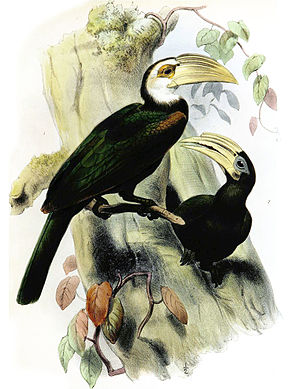Sulawesi hornbill
| Sulawesi hornbill | ||||||||||
|---|---|---|---|---|---|---|---|---|---|---|

Sulawesi hornbills |
||||||||||
| Systematics | ||||||||||
|
||||||||||
| Scientific name | ||||||||||
| Penelopides exarhatus | ||||||||||
| ( Temminck , 1823) |
The Sulawesi hornbill ( Penelopides exarhatus ) is a species of bird in the hornbill family that occurs in two subspecies in Southeast Asia.
The stock situation of the Sulawesi hornbill was classified in the IUCN Red List of Threatened Species in 2016 as " Vulnerable (VU) " = "endangered".
Appearance
The Sulawesi hornbill is a relatively small hornbill with a body length of 45 centimeters. The male's tail is 19.5 centimeters on average, while the female's tail is slightly shorter at 18.1 centimeters. The beak of the male is on average 9.7 centimeters long, that of the female is slightly shorter with an average of 9.1 centimeters. The sex dimorphism in this species is so pronounced that the sexes can be distinguished by field observation.
Appearance of the male
The male has predominantly black body plumage. This plumage shimmers metallic green on the upper side of the body. The face and throat are white. The beak is horn-colored, on the lower beak there is a brown to black-brown spot at the base of the beak, which can be very extensive. The narrow ridge of the beak is brown and ends abruptly before the end of the beak.
The featherless skin around the eye and the bare throat patch are flesh-colored. The eyes are red, the legs and feet are black.
Features of the female and young birds
The adult females have a body plumage that is largely similar to that of the males. However, they also have black feathered faces. They are a bit smaller overall. The ridge of the beak ends at half the length of the beak and the dark spot on the lower beak is either small or missing completely. The featherless skin around the eye is black. There is a narrow yellow stripe below the eye. The featherless skin on the throat is yellow to flesh-colored.
The young birds of both sexes resemble the adult male, only the beak is a bit smaller overall, the beak ridge hardly developed. The beak is light yellow, the featherless skin of the face is pale yellow, the eyes are dark brown. Young females molt into the plumage of adult birds when they are one year old.
Distribution area, habitat and endangerment.
The range of the Sulawesi hornbill is the island of Sulawesi and the adjacent islands of Muna and Buton .
The habitat of Sulawesi is evergreen primary forest up to an altitude of 1100 meters. It is most common in the forests of the lowlands and mountain forests at lower altitudes. Due to the increasing deforestation of the island, the population of the Sulawesi hornbill is endangered.
Way of life
The Sulawesi hornbill is commonly found in small family groups of four to eight birds. It stays mainly in the lower treetop area and looks for food in the foliage. Carefully searching through foliage and then moving to the nearest tree leads Alan Kemp to conclude that animal protein plays a major role in diet.
Since the Sulawesi hornbill is observed in groups all year round, it is assumed that it has a cooperative breeding behavior similar to the Luzon hornbill . Only the dominant breeding pair starts breeding, the male is supported by helpers in caring for females and later young birds.
Sulawesi hornbill and human
On the island of Sulawesi, the Sulawesi hornbill is hunted by the local population. It is occasionally kept as a pet.
literature
- W. Grummt , H. Strehlow (Ed.): Zoo animal keeping birds. Verlag Harri Deutsch, Frankfurt am Main 2009, ISBN 978-3-8171-1636-2 .
- Alan Kemp: The Hornbills - Bucerotiformes . Oxford University Press, Oxford 1995, ISBN 0-19-857729-X .
Web links
- Rhabdotorrhinus exarhatus in the endangered Red List species the IUCN 2012. Posted by: BirdLife International, 2012. Accessed November 19, 2016th
